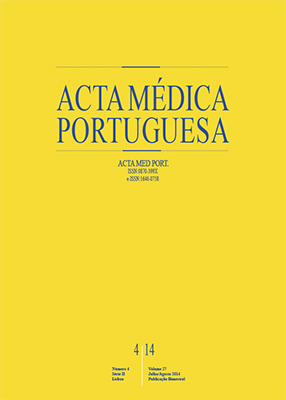Presentation of the Anatomical and Clinical Method of Direct Faciometrics in Children with Propaedeutic Purpose
DOI:
https://doi.org/10.20344/amp.5085Abstract
Introduction: We introduce the concept of direct faciometrics with propaedeutic purpose, underlying the measurement of growth in infant face, with relevant advantages over other methods.Material and Methods: We observed 102 healthy Caucasian children of both gender, aged up to 14 years (included) who accessed the consultation of Pediatric Stomatology of Lisboa- Norte Hospital Centre, from May 1, 2011 and during one year. We evaluated the degree of facial growth and its characteristics, based on linear and angle measurements obtained from reference points located on facial surface. Systematic records in front and profile were performed; linear and angle measures were noted with respectively a digital caliper and a digital goniometer. We used the statistical method of applying correlation tables and ANOVA test of two factors.
Results: We deliver results and constructed growth curves.
Discussion: We observed a growth spurt of anteroposterior face until the age of 6, which continues attenuated until the aged of 9. From 9 to 12 years old there has been a new growth spurt, which becomes residual from this age on. There were no significant changes in age angle mean values or gender differences in facial growth. The inter-observer error was 0.62 mm for linear values and 2.65 degrees for angle values.
Conclusions: This is a reliable method, without image or radiation, non-invasive, simple, inexpensive and reproducible. Recommended for use in Pediatric Dentistry and Pediatrics, constituting a semiological resource that allows an early diagnosis of facial growth abnormalities in children, and hence their timely interception and correction.
Keywords: Anthropometry; Anatomy; Child; Facial analysis; Soft tissue; Examinations and diagnosis.
Downloads
Downloads
Published
How to Cite
Issue
Section
License
All the articles published in the AMP are open access and comply with the requirements of funding agencies or academic institutions. The AMP is governed by the terms of the Creative Commons ‘Attribution – Non-Commercial Use - (CC-BY-NC)’ license, regarding the use by third parties.
It is the author’s responsibility to obtain approval for the reproduction of figures, tables, etc. from other publications.
Upon acceptance of an article for publication, the authors will be asked to complete the ICMJE “Copyright Liability and Copyright Sharing Statement “(http://www.actamedicaportuguesa.com/info/AMP-NormasPublicacao.pdf) and the “Declaration of Potential Conflicts of Interest” (http:// www.icmje.org/conflicts-of-interest). An e-mail will be sent to the corresponding author to acknowledge receipt of the manuscript.
After publication, the authors are authorised to make their articles available in repositories of their institutions of origin, as long as they always mention where they were published and according to the Creative Commons license.









